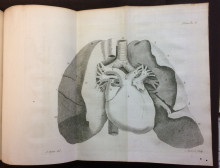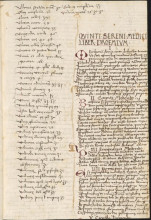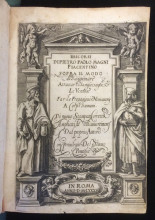Pablo Alvarez
Posts tagged with history of medicine in Blog Beyond the Reading Room
Showing 1 - 5 of 5 items

Join the Special Collections Research Center in Hatcher next Tuesday (13 December) at 4 pm for our final After Hours open house of the term exploring a selection of artifacts illustrating the early history of western medicine.

On behalf of the University of Michigan Library we want to express our most sincere gratitude to Marty and Marilyn Lindenauer for their generous donation that allowed us to acquire a series of books and artifacts for our History of Medicine Collection.

The Liber medicinalis (Book of Medicine) is a medical treatise of around 1,200 dactylic hexameters, traditionally attributed
to the second-century Roman author, Quintus Serenus Sammonicus (d. beginning of 3rd c. AD). It contains sixty-four therapeutic recipes,
divided into two sections: recipes for illnesses affecting individual organs listed from head to toe, and recipes for general ailments like injuries, fevers, fractures and dislocations, insomnia, toothache, and poisoning.
to the second-century Roman author, Quintus Serenus Sammonicus (d. beginning of 3rd c. AD). It contains sixty-four therapeutic recipes,
divided into two sections: recipes for illnesses affecting individual organs listed from head to toe, and recipes for general ailments like injuries, fevers, fractures and dislocations, insomnia, toothache, and poisoning.

Our featured book today is a fourteenth-century Latin manuscript of a medieval bestseller: the Secret of Secrets (Secretum secretorum). Wrongly attributed to Aristotle, and originally composed in Arabic in the eighth century, the content of this work has been gradually shaped, and changed, by scribes and translators throughout the centuries. From being conceived as a manual about kingship, it eventually became one of the most popular medical treatises in the Middle Ages.

Our featured book is a copy of the second edition of the famous sixteenth-century blood-letting treatise for barber-surgeons, Discourses of Pietro Paolo Magni of Piacenza on how to bleed, attach leeches and cups, perform massages and blistering to the human body (Discorsi di Pietro Paolo Magni piacentino sopra il mondo di sanguinare, attaccar le sanguisugue, & le ventose far le fregagione & vessicatorij a corpi humani). It was published in Rome in 1586.